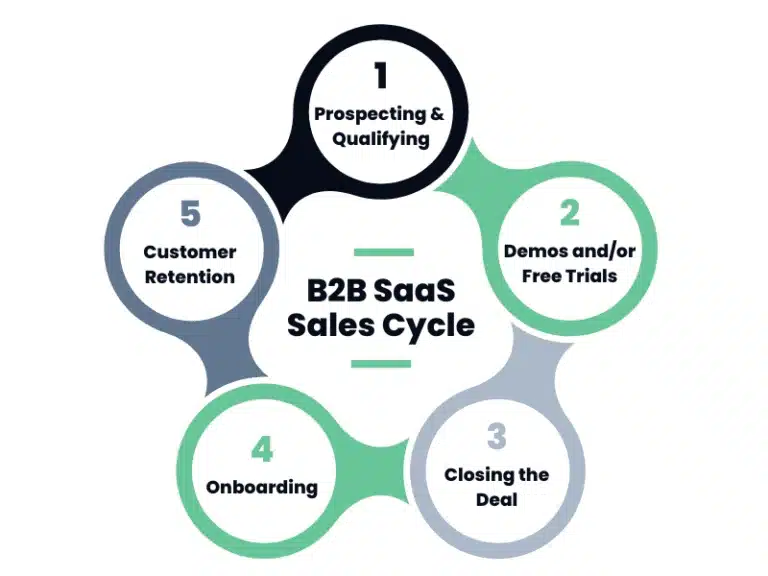If you’re running a B2B SaaS company, you know that the industry is experiencing explosive growth. According to the experts at Statista, “In 2023, the software as a service (SaaS) market is estimated to be worth approximately 197 billion U.S. dollars and estimated to reach 232 billion U.S. dollars by 2024,” and there’s no end in sight. To succeed, every provider from startups to dominant industry giants needs a carefully orchestrated B2B SaaS sales cycle that conclusively converts leads into long-term customers.
Creating the right type of B2B SaaS sales cycle for your company requires you to understand:
- SaaS sales models.
- The typical stages of the sales cycle and differences among different vertical markets.
- How the sales cycle and your churn rate are connected.
- How marketing affects the success of the sales cycle.

B2B SaaS Sales Cycle Models
SaaS sales are different from merchandise sales. When you sell tangible goods, the customer makes a one-time decision to purchase. When you sell a B2B SaaS product, the customer must decide to subscribe. You’re selling a long-term relationship.
Your SaaS sales cycle defines all the activities necessary to attract leads, convert them to customers, and provide ongoing nurturing to keep customers loyal over the long term. The sales cycle needs to be tailored for every company; however, there are typically three B2B SaaS sales models.
- Self-Service. If you’re selling a basic and affordable SaaS product, the prospect typically won’t interact with a sales team. A self-service sales model focuses on lead generation, educating the lead to encourage them to subscribe, and a simple onboarding process.
- Transactional. This model is most often found in SaaS organizations that sell a simple product at a premium price. Given the cost of the subscription, your sales team will need to work with leads who want to feel confident that they’re making the right choice. In the transactional model, you’ll focus on lead generation, education, and some interaction with a sales team via telephone. Once the prospect is sure they’ve found the best solution, the decision to subscribe is relatively straightforward.
- Enterprise. When selling to an enterprise, the B2B SaaS sales cycle is typically quite long. For example, if you are selling an Enterprise Resource Planning (ERP) system, you’ll find many stakeholders in the lead’s organization who want to ensure that the ERP system meets everyone’s requirements. ERP is a mission-critical application that can have a major impact on the business, and the cost of such a system is significant. It can months to convince all decision-makers. Selling B2B SaaS to enterprises is risky. If the deal doesn’t close, you’ve invested significant resources with no payoff. Enterprise sales require a skilled and patient team. Optimizing the sales cycle for enterprise B2B SaaS companies involves addressing the complex needs of large organizations, which require tailored solutions and long-term relationship building.

The B2B SaaS Sales Cycle
All B2B SaaS sales models use the same sales cycle, but the emphasis is different for each model. Typically, the sales cycle includes the following steps.
1. Prospecting and Qualifying
You’ll need to find individuals who would be good prospects for your SaaS offering. Companies using a self-service model generally employ a SaaS marketing strategy that focuses on automation. That strategy might include things such as SEO, pay-per-click advertising and retargeting, and content and social media marketing.
More complex sales models require effort in addition to the automated approaches listed above. Your marketing and sales teams will need automated support from a system like HubSpot. Your staff can improve productivity and results with support in tracking leads and qualified prospects, managing contacts and opportunities, managing social media, automating email marketing campaigns, and more.
2. Demonstrations and/or Free Trials
Regardless of your sales model, your leads will want to see how your B2B SaaS solution works firsthand. You can accomplish this with free trials, which work especially well for self-service and transactional sales models. You can also prepare videos that illustrate how various aspects of your product work. They can be useful to encourage leads to set up their free trial.
For enterprise sales models, a more personalized approach is typically required. Prepare demonstrations that can be presented in person or via video conferencing. You may prepare overview demonstrations and, depending on your product, you may need demonstrations that explain usage on a departmental basis. Make sure your demonstrations include adequate time to answer questions.

3. Closing the Deal
For self-serve and transactional sales models, if a lead doesn’t subscribe, you can follow up by email or personal contact to discuss the benefits of your solution. You can also provide additional incentives such as offering a discount or extending a trial.
For enterprise sales, you’ll need to follow more traditional sales strategies. For example, stay in touch with your lead during the trial period to answer questions and objections. Sales teams should be armed with appropriate objection-handling tools to get buy-in from the stakeholders you identified earlier in the B2B SaaS sales cycle.
Prepare a proposal that clearly defines how your solution will solve the lead’s problems and describes terms and pricing. You may need to negotiate with several people or teams in enterprise organizations to obtain a signed contract.
4. Onboarding
After the lead commits, effective onboarding and continued customer support are essential. Make sure your onboarding process addresses everything that must be done to allow your customers to realize the benefits they expect from your B2B SaaS product. If your onboarding is lacking, you’ll find your churn rate increasing significantly.
5. Customer Retention
Customer retention strategies may not always be included in a B2B SaaS sales cycle but, in the B2B SaaS industry, it’s helpful. You need to establish a customer-focused philosophy that will help your company grow. Staying in touch with new customers will help you to provide the encouragement they may need as they integrate your offering into their operations. You’ll also get more referrals from satisfied customers. A focus on customer success and retention will go a long way toward controlling your churn rate.
While we’ve looked at a typical SaaS sales cycle, it’s not a one-size-fits-all undertaking. You’ll see differences depending on whether your product targets SMBs or enterprises. You’ll need to account for differences if you’re targeting regulated industries like healthcare or finance. In that case, your sales cycle may take longer.
The complexity of the SaaS solution you offer will also force differences in your approach and extend the length of your sales cycle. The more complex your offering, the higher the likelihood that multiple departments and a host of stakeholders will be involved.
Use Your B2B SaaS Sales Cycle to Control Churn
A well-structured SaaS sales cycle can help control churn in the following ways.
- Qualification. There will be less churn if you concentrate on finding qualified leads, providing clear descriptions, and effective demonstrations of your product.
- Onboarding. When customers are comfortable using your product and understand the benefits they can receive, your churn rate will be lower.
- Customer Retention. The sales cycle shouldn’t end after closing the sale or onboarding. Stay in touch with customers, elicit customer feedback and act on it, and take advantage of cross-selling and upselling opportunities.
Use Marketing to Increase the Success of Your SaaS Sales Cycle
A well-defined sales cycle, along with proactive marketing support, will improve the results of your sales efforts. Perhaps even more importantly, they will help you control your churn rate. In the SaaS industry, churn can eliminate any gains you see through new sales.
Closely integrate your sales and marketing operations. You’ll notice a role for the marketing team to support each step in a typical B2B SaaS sales cycle. Your success will depend on successfully navigating the intricate sales cycle to establish long-lasting relationships with your clients.
Boost your company’s success by integrating expert marketing at every stage of the B2B SaaS sales cycle. Reach out to Bay Leaf Digital. Let’s talk about how our team can help with winning strategy, effective SEO, engaging content, and so much more.



